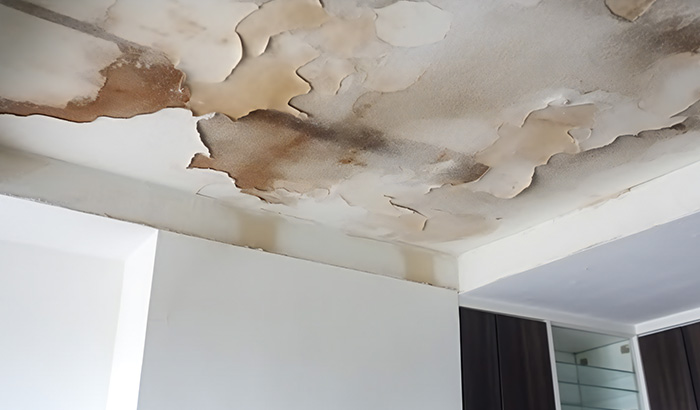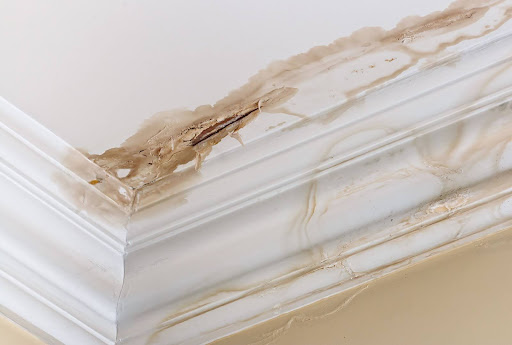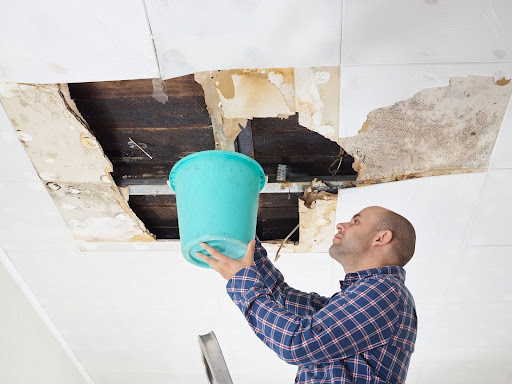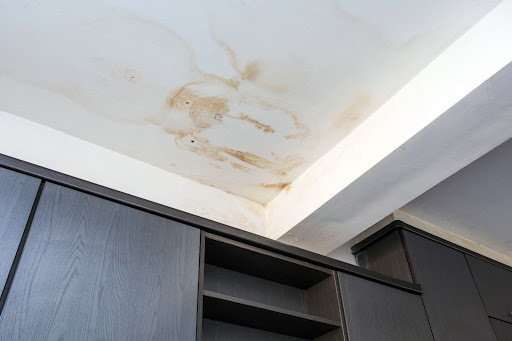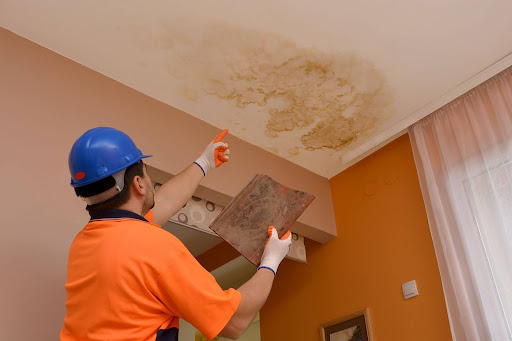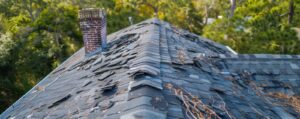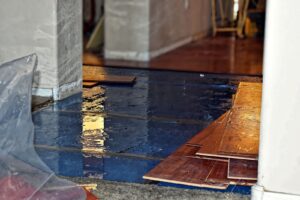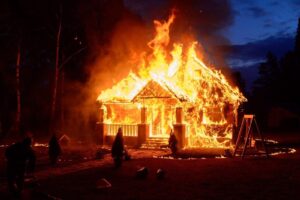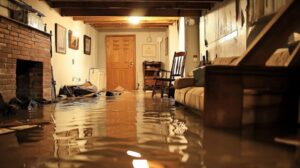Water damage in ceilings isn’t always obvious at first glance. Sometimes, the signs are silent, sneaky, or subtle. However, simply because water damage in a ceiling isn’t noticeable doesn’t mean it isn’t a serious issue.
Identifying water damage early is crucial to prevent more extensive problems down the line. Ceilings fall victim to water damage through various means, such as roof leaks, plumbing issues, or even high humidity levels.
Recognizing the signs of ceiling water damage and understanding its causes will help you take timely action to address the issue and protect your home from further harm.
Signs of water damage in a ceiling
We’ve compiled some of the telltale signs of water damage in ceilings, common causes, and the importance of addressing it promptly so you can confidently care for and protect your home.
Here are some key signs to watch out for:
Stains and discoloration
Water stains on your ceiling are one of the most noticeable indicators of water damage. These stains may appear as dark spots or discoloration and vary in size and shape.
Sagging or bulging areas
If your ceiling begins to sag or bulge, it’s a clear sign of water damage. This happens when water accumulates in the ceiling material, causing it to lose its structural integrity.
Peeling paint or wallpaper
Moisture from water damage causes paint or wallpaper to peel, bubble, or blister on your ceiling. Obviously, this impacts the aesthetics of your home. More importantly, though, it indicates a serious underlying issue.
Mold or mildew growth
Water damage provides the ideal environment for mold and mildew to thrive. In addition to causing possible structural damage, mold and mildew might cause health issues for you and your family. If you spot any signs of mold growth on your ceiling, be absolutely sure to address it promptly and properly.
Dripping or pooling water
The most obvious sign of a current water leak is the presence of dripping or pooling water coming from your ceiling. If you see water actively coming through, it’s crucial to locate and address the source of the leak immediately.
Keep in mind that water damage isn’t always visible on the ceiling’s surface, so it’s essential to inspect your home thoroughly, especially after heavy rains or plumbing incidents.
Common causes of ceiling water damage
Understanding the common causes of ceiling water damage is essential in helping you identify and address potential issues promptly. Let’s discuss the various factors that lead to water damage in your ceiling:
Roof leaks
One prevalent cause of ceiling water damage is roof leaks. Your roof is your home’s first line of defense against the elements, and when it becomes compromised, water might seep through and infiltrate your ceiling. Roof leaks usually result from damaged shingles, worn-out roofing materials, clogged gutters, or even the presence of ice dams in colder climates.
Plumbing issues
Faulty or deteriorating plumbing systems within your home lead to water damage in your ceiling. Leaking pipes, burst water lines, or plumbing fixtures that are not properly sealed all contribute to water infiltrating your ceiling. These issues are often hidden from plain sight but have significant consequences.
Condensation and humidity
High humidity levels and condensation are also culprits behind ceiling water damage. When warm, moist air comes into contact with cooler surfaces within your home, it might condense into water droplets. Over time, this moisture buildup leads to water damage and even mold growth on your ceiling.
Flooding or water intrusion
In some cases, water damage to your ceiling may result from flooding or water intrusion due to severe weather events or external factors. Heavy rainfall, flash floods, or a compromised foundation might allow water to enter your home, affecting your ceiling and other areas of your property.
Regularly inspecting and maintaining your roof, plumbing, and humidity levels will help safeguard your home against these issues.
The dangers of ignoring ceiling water damage
By now, you’ve hopefully realized that ceiling water damage is most often more than a cosmetic issue and usually leads to more severe problems if left unattended.
Structural damage
Water weakens the materials that make up your ceiling, like drywall or plaster. Over time, this compromises the integrity of your ceiling and potentially leads to collapses or other structural failures.
Mold and health risks
Mold begins to thrive within 24 to 48 hours of water exposure. The health risks associated with mold include respiratory issues, allergies, skin irritations, and even more severe conditions in some cases. It’s not something you want to expose yourself or your family to.
Increased repair costs
What might have been a relatively minor repair can quickly turn into a costly project involving fixing the entire ceiling and addressing structural issues or mold remediation. The longer you wait, the more expensive the repairs become.
What to do if you suspect ceiling water damage
Inspection and assessment
Begin by visually inspecting your ceiling for any of the signs of water damage we went over earlier. Take a moment to carefully observe and make note of these affected areas, including their size and location.
Be thorough in your examination, as water damage often extends beyond the ceiling itself and may impact nearby walls and floors. Make sure to shine a flashlight into those hard-to-reach corners and crevices to ensure you don’t miss any hidden issues. This diligent assessment will help you identify the full extent of the problem.
Addressing the source of the damage
Once you’ve identified those troublesome areas on your ceiling, the next detective task is uncovering the source behind this unwelcome water presence.
It could be a myriad of things — a roof that’s seen better days, a pipe that decided to spring a leak, plumbing that’s no longer in tip-top shape, or even an issue as seemingly innocuous as excess humidity leading to condensation.
For minor issues, like a pesky leaking pipe, you might be able to apply a temporary fix to staunch the flow until you can orchestrate proper repairs.
However, for more intricate matters, it’s advisable to collaborate with a seasoned professional, perhaps a contractor or a skilled plumber. Their expertise will prove invaluable in precisely tracking down and effectively remedying the root cause of the water damage, ensuring your home stays dry and secure.
Cleanup and restoration
The severity of the damage will determine the necessary steps moving forward.
If you’re dealing with a significant issue, it is best to bid farewell to any wet or compromised materials like insulation, drywall, or ceiling tiles. Removing these items is a preventive measure to thwart the potential mold growth. Be sure to handle their disposal correctly to avoid inadvertently encouraging mold growth elsewhere.
If the damage is more extensive than you feel comfortable handling, don’t hesitate to seek professional help. Consider consulting a restoration specialist or contractor. Their expertise will prove invaluable in restoring your ceiling and, by extension, your home to its pre-damage condition.
Prevention tips to avoid ceiling water damage
Preventing ceiling water damage is essential for the overall well-being of your home. Here are some valuable prevention tips to keep your property safe and sound:
Regular maintenance
- Make it a habit to schedule routine inspections of critical areas in your home, including plumbing, roof, and ceilings. Look out for any signs of leaks, corrosion, or general wear and tear.
- Don’t forget to pay attention to your household appliances, such as washing machines, dishwashers, and water heaters. Ensure they are in excellent working condition, and replace any aging components that might pose a risk of leaks.
- Properly maintaining your gutters and downspouts is crucial to ensure they’re clear and free-flowing. This will prevent water from overflowing onto your roof or walls during heavy rain.
Roof inspections
- Regular roof inspections are a must. They help you identify and address issues like damaged or missing shingles, faulty flashing, or roof vents that might lead to leaks.
- Keep your roof clean by clearing away debris like leaves and branches. This simple step prevents clogs in your gutter system and allows water to flow off your roof effectively.
Plumbing maintenance
- Inspect your plumbing system for telltale signs of leaks, drips, or unusual noises. Promptly address any plumbing issues to prevent potential water damage.
- Consider installing water leak detection devices or smart water meters that provide early warnings of possible leaks, allowing you to take swift action.
- In regions with cold winters, insulate pipes in unheated areas of your home to prevent freezing and bursting during freezing temperatures.
Proper ventilation
- Ensure your home has sufficient ventilation, particularly in areas where moisture tends to accumulate, such as bathrooms, kitchens, and basements.
- Utilize exhaust fans or open windows when necessary to reduce humidity levels and prevent condensation on ceilings and walls.
- Proper attic insulation is essential to regulate temperature and avoid the formation of ice dams on your roof during winter.
By proactively implementing these preventive measures, you significantly reduce the risk of ceiling water damage and maintain a safe, resilient home.
You can trust Total Flood & Fire Restoration
When it comes to dealing with water damage, it’s always a good idea to seek professional assistance. That’s where Total Flood & Fire Restoration comes in. With our wealth of experience and expertise, we’ll help you safeguard your home, address any water-related issues, and provide valuable guidance on prevention.
Don’t wait until a minor issue turns into a major problem. Take action now to protect your home, loved ones, and investment. Call Total Flood & Fire Restoration at 385-483-2109 for restoration services you can totally trust.

